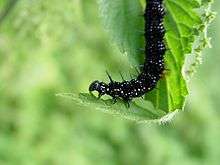Larval food plants of Lepidoptera

Caterpillars (larvae) of Lepidoptera species (i.e. of butterflies and moths) are mostly (though not exclusively) herbivores, often oligophagous, i.e. feeding on a narrow variety of plant species (mostly on their leaves, but sometimes on fruit or other parts.
Lepidopteran larvae often require specific species of food plants.[1][2][3] It also makes some of them important pests in agriculture or forestry. The host plants have yet to be determined for some species. There is not always consensus among lepidopterists over the listing of suitable plants.
Adult females normally lay their eggs on or near specific food plants (which often have to be abundant enough). Lepidopteran larvae can often be raised on a variety food plants and commercial mixtures.[4] Closely related Lepidoptera tend to have similar food plant preferences. Many caterpillars sequester the toxins from their food plants and use them as a defense against predators.[5] Though it is common for Lepidoptera to prefer a certain plant genus or family, some species feed on a narrow selection of unrelated taxa. The choice is unrelated to nectar plant preferences of adult Lepidoptera, which are much less strict.
Lists
- List of Lepidoptera that feed on Abelia
- List of Lepidoptera that feed on Achillea
- List of Lepidoptera that feed on alders
- List of Lepidoptera that feed on Artemisia
- List of Lepidoptera that feed on ashes
- List of Lepidoptera that feed on Aster
- List of Lepidoptera that feed on Atriplex
- List of Lepidoptera that feed on beeches
- List of Lepidoptera that feed on beets
- List of Lepidoptera that feed on birches
- List of Lepidoptera that feed on Brassica
- List of Lepidoptera that feed on brooms
- List of Lepidoptera that feed on buckthorns
- List of Lepidoptera that feed on Buddleja
- List of Lepidoptera that feed on Calluna
- List of Lepidoptera that feed on Camellia
- List of Lepidoptera that feed on Centaurea
- List of Lepidoptera that feed on Chenopodium
- List of Lepidoptera that feed on chestnut trees
- List of Lepidoptera that feed on chrysanthemums
- List of Lepidoptera that feed on Cirsium
- List of Lepidoptera that feed on clovers
- List of Lepidoptera that feed on cotton plants
- List of Lepidoptera that feed on currants
- List of Lepidoptera that feed on dandelions
- List of Lepidoptera that feed on elms
- List of Lepidoptera that feed on Eucalyptus
- List of Lepidoptera that feed on Galium
- List of Lepidoptera that feed on goldenrods
- List of Lepidoptera that feed on grapevines
- List of Lepidoptera that feed on grasses
- List of Lepidoptera that feed on hawthorns
- List of Lepidoptera that feed on hazels
- List of Lepidoptera that feed on Helianthus
- List of Lepidoptera that feed on honeysuckles
- List of Lepidoptera that feed on Ipomoea
- List of Lepidoptera that feed on Juncus
- List of Lepidoptera that feed on larches
- List of Lepidoptera that feed on lettuces
- List of Lepidoptera that feed on Lotus
- List of Lepidoptera that feed on Malus
- List of Lepidoptera that feed on maples
- List of Lepidoptera that feed on oaks
- List of Lepidoptera that feed on pear trees
- List of Lepidoptera that feed on pines
- List of Lepidoptera that feed on plantains
- List of Lepidoptera that feed on Polygonum
- List of Lepidoptera that feed on poplars
- List of Lepidoptera that feed on Potentilla
- List of Lepidoptera that feed on Prunus
- List of Lepidoptera that feed on ragweeds
- List of Lepidoptera that feed on rhododendrons
- List of Lepidoptera that feed on roses
- List of Lepidoptera that feed on Rubus
- List of Lepidoptera that feed on Rumex
- List of Lepidoptera that feed on Senecio
- List of Lepidoptera that feed on Silene
- List of Lepidoptera that feed on Solanum
- List of Lepidoptera that feed on Sorbus
- List of Lepidoptera that feed on spruces
- List of Lepidoptera that feed on strawberry plants
- List of Lepidoptera that feed on Tilia
- List of Lepidoptera that feed on Vaccinium
- List of Lepidoptera that feed on Viburnum
- List of Lepidoptera that feed on willows
External links
- HOSTS - a Database of the World's Lepidopteran Hostplants. By Gaden S. Robinson, Phillip R. Ackery, Ian J. Kitching, George W. Beccaloni and Luis M. Hernández @ Natural History Museum, London.
- Larval food plant information sorted by plant. Compiled by Markku Savela.
References
- ↑ Klots, Alexander B. (1951). A Field Guide to the Butterflies of North America, East of the Great Plains (Tenth ed.). Boston: Houghton Mifflin Company. pp. 333–338. ISBN 0395078652.
- ↑ "HOSTS - The Hostplants and Caterpillars Database at the Natural History Museum". nhm.ac.uk. Retrieved 13 May 2015.
- ↑ An example of a species being restricted to its host plant ranges is documented for the monarch butterfly by Sue Halpern in her book: . Four Wings and a Prayer,(2002), Kindle edition location 1594. New York, New York: Random House.ISBN 978-0-307-78720-0
- ↑ "Artificial Butterfly Diets". Educational Science. Retrieved 2015-03-08.
- ↑ "ADW: Danaus plexippus: INFORMATION". Animal Diversity Web, University of Michigan. Retrieved 2015-03-08.
.jpg)